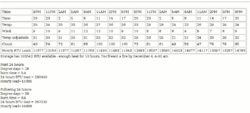Due to overwhelming popular demand, I'm putting my fire planning tool on the web for anyone who wants to use it. It's at http://www.nofossil.org/weather/delphi.php and is somewhat documented. You'll need at least an educated guess for the following data:
- Your latitude and longitude. It doesn't do Zip Code.
- Your temperature-independent base heat load (DHW, primarily)
- Wind factor: how much wind affects your heat load. The default is probably fine.
- Temperature factor: BTU heat loss per degree day for your house. Can be derived from Slantfin or history.
- Approximate hourly boiler output: probably about 75% of rated capacity
- Degree day base temperature. Usually 65, though I use 60.
It will likely take a bit of tweaking to get useful results, but feel free to play with it. Comments and suggestions are welcome as always.
- Your latitude and longitude. It doesn't do Zip Code.
- Your temperature-independent base heat load (DHW, primarily)
- Wind factor: how much wind affects your heat load. The default is probably fine.
- Temperature factor: BTU heat loss per degree day for your house. Can be derived from Slantfin or history.
- Approximate hourly boiler output: probably about 75% of rated capacity
- Degree day base temperature. Usually 65, though I use 60.
It will likely take a bit of tweaking to get useful results, but feel free to play with it. Comments and suggestions are welcome as always.



